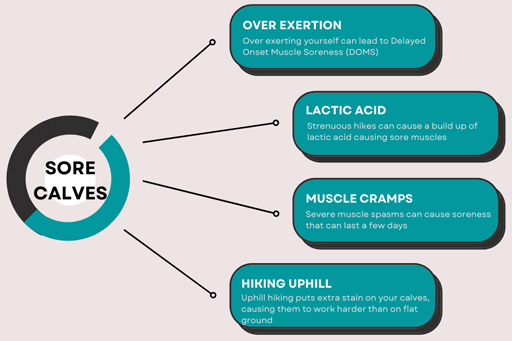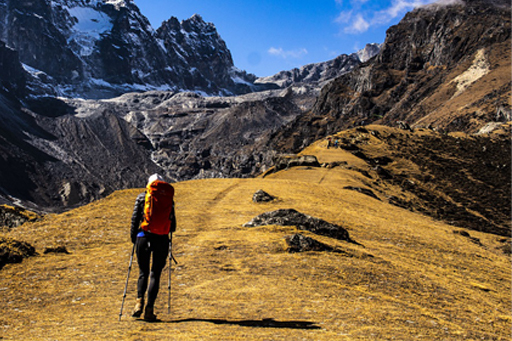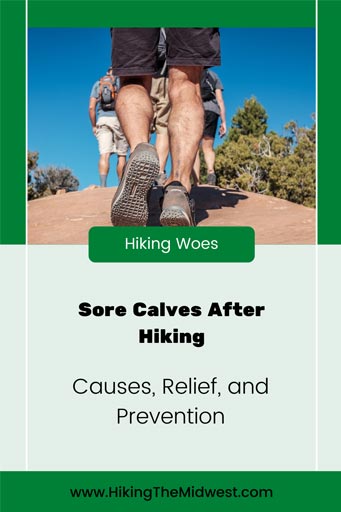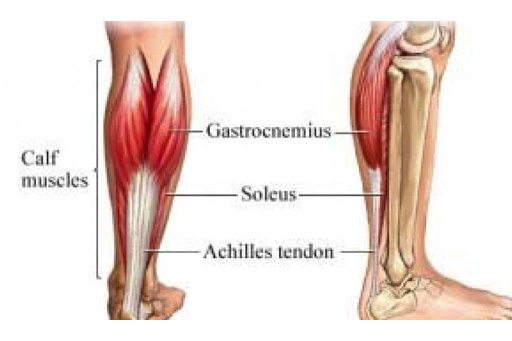As any experienced hiker knows, sore calves are an almost inevitable part of the hiking journey. You push yourself to the limit, climbing higher and covering more ground than you ever have before. The views from the top of the mountain were worth it, but your calves are screaming at you for mercy. What if there was a way to prevent those sore muscles from developing in the first place? Or to speed up your recovery if you’re already suffering? As it turns out, there is – and I’m going to share with you how to do it. Keep reading for some helpful tips on avoiding calf pain while hiking.
Table of Contents
What Causes Sore Calves After Hiking?
It’s a feeling many hikers know all too well – the pain and stiffness in your calves muscles the day after a hike. But what causes this soreness, and is there anything you can do to prevent it? Let’s take a look at some of the most common causes of calf soreness after hiking and offer some tips for avoiding them.

Overexertion
Working your body too hard can cause delayed onset muscle soreness, or DOMS. When you work your muscles they go through hypertrophy, which is basically your muscle rebuilding or getting bigger. DOMS is the soreness you feel while this is happening.
How to Decrease Pain Caused by DOMS
Ibuprofen or other anti-inflammatory medicine
Ice Bath Not the first thing you’ll find me running to try, but there’s a reason athletes willingly submerge at least parts of themselves in icy water. Studies show that icing muscles soon after overexerting them can reduce inflammation and slow muscle growth, both things that play a part in causing soreness.
Sports Massage While no one is really 100% sure that massage can speed up muscle recovery, but studies done have shown promise. Researchers at Ohio State University found that Swedish massage did lead to less inflammation and less damage in muscles.
Lactic Acid Build Up
When your muscles work hard, lactic acid is produced by and build up in your muscles. When you’re hiking, your calves are one of the most worked muscles in your leg, especially when you’re hiking uphill. That steep incline you just conquered is probably going to cause some lactic acid build up.
How to Get Rid of Lactic Acid Build Up
You’ve worked hard during a hike and now your calves are sore. How do you get rid of that built up lactic acid?
Drink Orange Juice before your hike. There was a study done showing that drinking some o.j. before your workout can decrease lactate levels by 27% and lessen muscle fatigue.
Stay Hydrated. Staying hydrated before, during, and after a hike can help prevent sore calves. Drinking plenty of water will flush out lactic acid and can prevent muscle cramps.
Breathe. A clinical trial done by Vemana Yoga Research Institute show that a controlled breathing technique known as pranayama can help reduce lactate levels.
Keep Moving. Staying mobile after an intense hike can clear lactic acid from your body faster than if you were to rest. This 2014 study shows that active recovery is much more efficient at preventing sore muscles than passive recovery.

Hiking Uphill
Any movement that lifts your heel off the floor is working your calf muscle. When you’re hiking on an incline, you’re also working against gravity and making your muscles work harder to propel you forward.
Calf Cramping
I’ll never forget the first time I suffered a cramp in my calf. I awoke to the most intense pain I had ever felt in the back of my leg. Instinctively, I sat up and tried to pull my feet towards me so I could grab my calf. As I pulled my foot back, the pain increased and I shot my leg right back out, straight, and leaned forward to try to hold my calf. Upon leaning forward, the pain disappeared just as quickly as it showed up. Turns out, stretching toward your toes is one of the fastest ways to stop a calf cramp. To this day, that was the worst calf cramp I’ve ever experienced, and my muscle was sore for the next couple days.
What caused that horrible cramp? The day I had spent wandering the local woods with friends and climbing up and down the steep hills for hours on end.
Common causes of cramping in the calves are
- Dehydration
- Muscle fatigue
- Too much exercise
- Inadequate electrolytes
- Not stretching enough
Remedies for Sore Calves
Soreness in your calves after a hike is normal, but here are some remedies to help ease the pain. Whether you’re suffering from delayed onset muscle soreness (DOMS) or just general fatigue, these tips can help.
Cold Treatment Using an ice pack on your calf for15-20 minutes at a time can give you some relief
Foam Roller
Rest Resting and elevating your leg will decrease swelling. This is a good one to do in combination with the ice pack method mentioned above.
How You Can Prevent Sore Calves
There’s nothing quite like the feeling of accomplishment that comes after a long hike. But unfortunately, sore calves can put a damper on things. Here are a few tips to help prevent sore calves before you start hiking.
Stretch Stretching is one of the easiest ways to prevent sore calves after hiking. Stretch it out before hitting the trail.
The Best Stretches for Calves
- Gastrocnemius Stretch
- Soleus Heel Drop Stretch
- Soleus Muscle Stretch
Wear the Right Footwear Supportive footwear helps keep the bones in your feet and ankles aligned, taking excess stress off your muscles. Good insoles can also help add support. Look for insoles that are firm, not gel-like and that cup your heel to prevent heel slippage. I’ve tried many insoles and though I love the squishy gel ones for everyday use, I’ve found solid ones to truly be better for hiking or walking on uneven or lumpy surfaces.
My Superfeet Trailblazer insoles have been a lifesaver on the trail. They feature a heel cup as well as an impact absorbing heel cushion that helps my feet stay where they’re supposed to and let me hike farther before muscle fatigue sets in.
Stay Hydrated Drinking water or electrolyte drinks help stave off muscle cramping and makes sure your body is hydrated enough to perform at its best.
Stretch Again Afterward After a strenuous or long hike, cool down with another stretch session.
If you want to prevent sore calves and enjoy your hike more, we recommend these tips. We hope this blog post has helped shed some light on the reasons for sore calf muscles after hiking and how they can be prevented. Let us know what other topics or questions about outdoor activities you’d like to see in future blogs!
Related Posts
Knees Hurt After Hiking? Read This Post!

